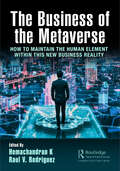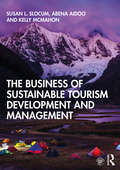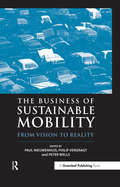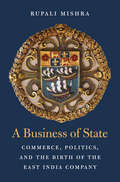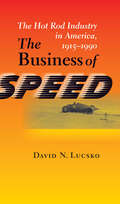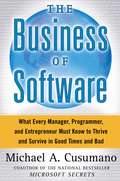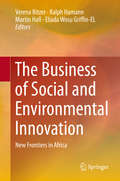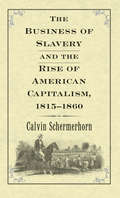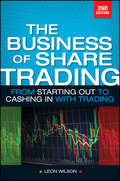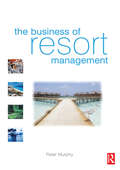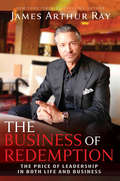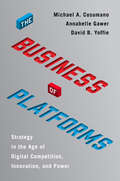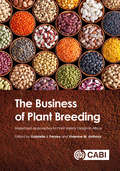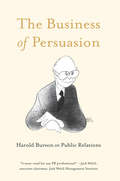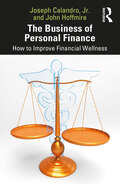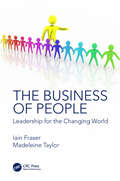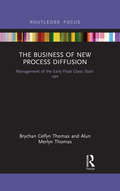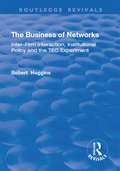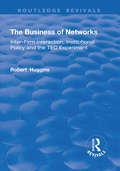- Table View
- List View
The Business of the Metaverse: How to Maintain the Human Element Within this New Business Reality
by K. Hemachandran Raul V. RodriguezThe metaverse is the future of business applications and models, and this ground-breaking book points and details a complete and clear picture of how the metaverse can impact the various business segments and how the human element will be maintained within the evolutionary change. This book serves as a guide for those planning to implement and expand the metaverse in their business as well as those already using it on limited levels. Simulated intelligence innovation can reveal intricate and significant examples in robust and information-rich situations that posture difficulties for human insight. In addition, similar to other burgeoning advancements, the experience and aptitudes accumulated by vendors and consumers, alongside the steady analysis of interactions and information, empower metaverse calculations to be refined and improved. This book illustrates the current advancements and results and expands the analysis of human-centric metaverse applications to business segments and their future effects on overall enterprise management. Essentially, this book elaborates on the impact of the metaverse across business sectors through the use of case studies.
The Business of the FIFA World Cup
by Simon ChadwickThe FIFA World Cup is arguably the biggest sporting event on earth. This book is the first to focus on the business and management of the World Cup, taking the reader from the initial stages of bidding and hosting decisions, through planning and organisation, to the eventual legacies of the competition. The book introduces the global context in which the World Cup takes place, surveying the history and evolution of the tournament and the geopolitical background against which bidding and hosting decisions take place. It examines all the key issues and debates which surround the tournament, from governance and corruption to security and the media, and looks closely at the technical processes that create the event, from planning and finance to marketing and fan engagement. Analysis of the Women’s World Cup is also embedded in every chapter, and the book also considers the significance of World Cup tournaments at age-group level. No sport business or management course is complete without some discussion of the FIFA World Cup, so this book is essential reading for any student, researcher or sport business professional looking to fully understand global sport business today.
The Business of Sustainable Tourism Development and Management
by Susan L. Slocum Abena Aidoo Kelly McMahonThe Business of Sustainable Tourism Development and Management provides a comprehensive introduction to sustainable tourism, crucially combining both theoretical and practical approaches to equip students with the tools to successfully manage a sustainable tourism business or destination. Covering a range of crucial topics such as mass tourism, alternative tourism, human capital management, and many more, this book incorporates a global curriculum that widens the sustainable tourism debate to include theoretical perspectives, applied research, best-practice frameworks, business tools, and case studies, facilitating a more comprehensive sustainable tourism educational strategy. Information on how to effectively implement strategies that can be applied to business environments, entrepreneurship, and job skills to enhance career preparation is at the forefront of this textbook. Highly illustrated and with an interactive companion website including bonus learning materials, this is the ideal textbook for students of tourism, hospitality, and events management at both undergraduate and postgraduate levels.
The Business of Sustainable Mobility: From Vision to Reality
by Peter Wells Paul Nieuwenhuis Philip VergragtIn many parts of the world, there is a crisis of mobility. The choices we have made over the past 200 years on modes and technologies of transport have brought us unprecedented global interaction and in many respects increased personal freedom. However, all this mobility has come at a cost to society, to the economy and to the environment. Mobility is in crisis, but few seem aware of the full extent of it. Though most people will be aware of congestion, accidents (although this aspect is often overlooked), parking restrictions or fuel prices, few will have considered the effects of the dramatic increase in mobility expected in China, India and elsewhere. Nor do many people in their daily lives consider the impact of climate change on our environment and the contribution our cars make to it. It is often thought that technology alone can solve this problem. For some observers, salvation could be achieved by means of hydrogen fuel cells, by hybrid cars, or by increased fuel efficiency, or even by telematics to reduce congestion. This book shows that "technology" may well not be enough in itself and that for a genuinely sustainable transport future far more radical change – affecting many aspects of society – is needed. It is likely, for example, that new business models are needed, as well as users and consumers adopting new forms of behaviour. Disruptive technological innovation may well contribute, but needs to be induced by a combination of market forces and government regulation.Many studies touch on transport and mobility issues and more mainstream books aimed at challenging the dominance of automobility are common, yet works dealing with the longer-term strategic, theoretical and broader conceptual issues needed to inform the move towards more sustainable transport are rare. Yet policy-makers, practitioners, as well as many sections of academia, acknowledge a need for guidance on new thinking on sustainable mobility. This book brings together a range of views representing both leading-edge thinking and best practice in the mobility sector. The individual expert contributions form the basis for framing a broader vision of future mobility and proposed transition trajectories towards that future.Much of the effort reflected in the chapters in this book is concerned with going beyond the "technofix" of new cars, to confront the more difficult challenges of institutional, cultural and social change within and beyond the industry that have to be resolved in the transition towards sustainability. It therefore seeks to break through the conventional boundary between engineering and the social sciences, and the contributors come from both sides of this traditional but unnecessary divide, combining economists, engineers, geographers, designers and others.The work is based on the sustainable mobility stream in the 2003 International Greening of Industry Network conference in San Francisco. This event brought together experts from industry and government, and the book combines some of the papers presented there, developed and updated into full chapters, with a number of additional chapters to capture some of the themes that emerged from the conference.The central problem addressed in this book is the private car: how to power it, how to build it and how to deliver it to customers in a more sustainable future. It starts with ideas of radical innovation in the propulsion system of the car, notably the hydrogen fuel cell. In one section, the book examines business models that could be used to deliver automobility in a more sustainable manner. This section looks at how the car is made and used, and looks beyond it by examining how we could change those aspects in our quest for sustainable mobility. The book then considers a number of recently introduced vehicles and alternative vehicle concepts within the context of a dominant existing paradigm. These vary from a minimalist single-seat commuter to a powertrain exchange concept that could breathe new life into the electric vehicle. A number of chapters then report on current practice
The Business of Studio Photography: How to Start and Run a Successful Photography Studio
by Edward R. LilleyThe Business of Studio Photography is packed with proven strategies for starting a new studio or improving an existing one-and now this classic book has been thoroughly updated and revised for the new digital-imaging era. Expert advice on every aspect of running a studio is featured: location, financing, equipment, digital shooting, proofing, and ordering; marketing, Web advertising, public relations and self-promotion; pricing, negotiating with labs, selling to the wedding, portrait, school, commercial, and art photography markets; digital imaging, business plans, and more. Equipment checklists and sample business forms, plus full resource lists for websites, magazines, and books are included. The Business of Studio Photography is the complete one-stop guide to opening and running a successful photography studio.
A Business of State: Commerce, Politics, and the Birth of the East India Company (Harvard historical studies #188)
by Rupali Mishra MishraAt the height of its power around 1800, the English East India Company controlled half of the world’s trade and deployed a vast network of political influencers at home and abroad. Yet the story of the Company’s beginnings in the early seventeenth century has remained largely untold. Rupali Mishra’s account of the East India Company’s formative years sheds new light on one of the most powerful corporations in the history of the world. From its birth in 1600, the East India Company lay at the heart of English political and economic life. The Company’s fortunes were determined by the leading figures of the Stuart era, from the monarch and his privy counselors to an extended cast of eminent courtiers and powerful merchants. Drawing on a host of overlooked and underutilized sources, Mishra reconstructs the inner life of the Company, laying bare the era’s fierce struggles to define the difference between public and private interests and the use and abuse of power. Unlike traditional accounts, which portray the Company as a private entity that came to assume the powers of a state, Mishra’s history makes clear that, from its inception, the East India Company was embedded within—and inseparable from—the state. A Business of State illuminates how the East India Company quickly came to inhabit such a unique role in England’s commercial and political ambitions. It also offers critical insights into the rise of the early modern English state and the expansion and development of its nascent empire.
The Business of Sports Agents
by Timothy Davis Kenneth L. ShropshireThe legendary Charles C. "Cash and Carry" Pyle, considered by most to be the first sports agent, negotiated a $3,000-per-game contract for Red Grange to play professional football for the Chicago Bears in 1933. Today, salaries in the tens of millions of dollars are commonplace, and instead of theatrical promoters and impresarios, professionally trained businessmen and lawyers dominate the business. But whereas rules and penalties govern the playing field, there are far fewer restrictions on agents. Incidents of agents' manipulating athletes, ranging from investment scams to outright theft of a player's money, are far too frequent, and there is growing consensus for reformIn The Business of Sports Agents, Kenneth L. Shropshire and Timothy Davis, experts in the fields of sports business and law, examine the history of the sports agent business and the rules and laws developed to regulate the profession. They also consider recommendations for reform, including uniform laws that would apply to all agents, redefining amateurism in college sports, and stiffening requirements for licensing agents. This revised and expanded second edition brings the volume up-to-date on recent changes in the industry, including:- the closing of one of the largest agencies- high-profile personnel moves- passage of the federal Sports Agent Responsibility and Trust Act- the National Football League's aggressive and high-profile efforts to regulate agents
The Business of Speed: The Hot Rod Industry in America, 1915–1990 (Johns Hopkins Studies in the History of Technology)
by David N. Lucsko2009 Outstanding Academic Title, ChoiceSince the mass production of Henry Ford’s Model T, car enthusiasts have been redesigning, rebuilding, and reengineering their vehicles for increased speed and technical efficiency. They purchase aftermarket parts, reconstruct engines, and enhance body designs, all in an effort to personalize and improve their vehicles. Why do these car enthusiasts modify their cars and where do they get their aftermarket parts? Here, David N. Lucsko provides the first scholarly history of America’s hot rod business. Lucsko examines the evolution of performance tuning through the lens of the $34-billion speed equipment industry that supports it. As early as 1910, dozens of small shops across the United States designed, manufactured, and sold add-on parts to consumers eager to employ new technologies as they tinkered with their cars. Operating for much of the twentieth century in the shadow of the Big Three automobile manufacturers—General Motors, Ford, and Chrysler—these businesses grew at an impressive rate, supplying young and old hot rodders with thousands of performance-boosting gadgets. Lucsko offers a rich and heretofore untold account of the culture and technology of the high-performance automotive aftermarket in the United States, offering a fresh perspective on the history of the automobile in America.
The Business of Software: What Every Manager, Programmer, and Entrepreneur Must Know to Thrive and Survive in Good Times and Bad
by Michael A. CusumanoThe world's leading expert on the global software industry and coauthor of the bestseller Microsoft Secrets reveals the inner workings of software giants like IBM, Microsoft, and Netscape and shows what it takes to create, develop, and manage a successful company -- in good times and bad -- in the most fiercely competitive business in the world. In the $600 billion software industry it is the business, not the technology, that determines success or failure. This fact -- one that thousands of once glamorous start-ups have unhappily discovered for themselves -- is the well-documented conclusion of this enormously readable and revealing new book by Michael Cusumano, based on nearly twenty years of research and consulting with software producers around the world. Cusumano builds on dozens of personal experiences and case studies to show how issues of strategy and organization are irrevocably linked with those of managing the technology and demonstrates that a thorough understanding of these issues is vital to success. At the heart of the book Cusumano poses seven questions that underpin a three-pronged management framework. He argues that companies must adopt one of three basic business models: become a products company at one end of the strategic spectrum, a services company at the other end, or a hybrid solutions company in between. The author describes the characteristics of the different models, evaluates their strengths and weaknesses, and shows how each is more or less appropriate for different stages in the evolution of a business as well as in good versus bad economic times. Readers will also find invaluable Cusumano's treatment of software development issues ranging from architecture and teams to project management and testing, as well as two chapters devoted to what it takes to create a successful software start-up. Highlights include eight fundamental guidelines for evaluating potential software winners and Cusumano's probing analysis, based on firsthand knowledge, of ten start-ups that have met with varying degrees of success. The Business of Software is timely essential reading for managers, programmers, entrepreneurs, and others who follow the global software industry.
The Business of Social and Environmental Innovation
by Verena Bitzer Ralph Hamann Martin Hall Eliada Wosu Griffin-ELIn the face of limited progress toward meeting Millennium Development Goals or addressing climate change and resource degradation, increasing attention turns to harnessing the entrepreneurial, innovative, managerial and financial capacities of business for improved social and environmental outcomes. A more proactive role for business in sustainable development is especially pertinent in sub-Saharan Africa, which has been plagued by conflict and poverty but shows signs of a brighter future as the world's second-fastest-growing region. The book considers how the socio-economic context influences the objectives of social innovation and even our definition of what we mean by social innovation. Secondly, the book aims to show how social innovation initiatives emerge and fare in context of the limited ability of many African countries to provide public goods and services.
The Business of Slavery and the Rise of American Capitalism, 18151860
by Prof. Jack Lawrence SchermerhornCalvin Schermerhorn’s provocative study views the development of modern American capitalism through the window of the nineteenth-century interstate slave trade. This eye-opening history follows money and ships as well as enslaved human beings to demonstrate how slavery was a national business supported by far-flung monetary and credit systems reaching across the Atlantic Ocean. The author details the anatomy of slave supply chains and the chains of credit and commodities that intersected with them in virtually every corner of the pre–Civil War United States, and explores how an institution that destroyed lives and families contributed greatly to the growth of the expanding republic’s capitalist economy.
The Business Of Share Trading: From Starting Out To Cashing In With Trading, Second Edition
by Leon WilsonSuccessful trader and best-selling author Leon Wilson knows how to make a living trading on the sharemarket. He also knows that because trading requires discipline, time and self-education, 90 per cent of those who attempt it will fail within two years. In concise and clear language, The Business of Share Trading, second edition, shows how you can take control and profit from an active sharemarket portfolio. From developing a plan and financing your capital investment, to setting up a home office and keeping accurate records, this newly expanded edition offers step-by-step guidance to all aspects of running a successful trading business. Updated to reflect the changes that have occurred in the industry over the past decade, the Business of Share Trading contains everything you need to know about: Fundamental, technical and combination analysis Dealing with brokers, data suppliers, ISPs and information sources Trend trading, break-out trading and reversal trading Trade entities and exits, position sizing and stop-loss management.
The Business of Resort Management
by Peter MurphyHow can owners and managers ensure that their considerable capital investments will return a competitive return on their investments? How can users and owners be sure they enjoy the promises of tantalizing marketing and real estate claims? Managing Sustainable Resorts Profitably combines business management principles with environmental and social concerns to offer development solutions to these questions. By taking an holistic and contemporary approach to the problem of developing sustainable tourism operations, this book provides a comprehensive assessment of the strategies that need to be considered by various governments, developers and, in particular, the customer-investor. The major features of resort development covered by this book include:• Environmental scanning of principal external and internal influential factors• The curse and blessings of seasonality• Competition for people’s recreation and retirement dollars• Guest activity programming• Environmental issues• Cruise ships as mobile resorts• Staffing issues in isolated areas• Financial challenges for owners and operators alike• Risk Management• Mutually beneficial options for various stakeholdersBased on an analysis of global resort opportunities and trends, the book focuses on those generic features that differentiate regional resort management from urban-centric management needs and priorities. Using comparative case studies the author emphases best case/benchmark examples of a range of resorts – large and small, urban and rural - to illustrate what can be achieved.
The Business of Redemption: The Price of Leadership in Both Life and Business
by James Arthur RayIn a world that often appears to be spinning out of control, there has possibly never been a time when the need for true leaders has been more urgent than today. Leadership is certainly an enigma. Some believe that a leader is someone who has followers. Does that mean that the person with the most Twitter followers or Facebook fans is a true leader? Hardly. While followers may be part of the equation, leadership cannot be about followers alone; and it can’t be just about winning the popular vote. In fact, some of the greatest leaders in history were the least popular. In The Business of Redemption, James Arthur Ray brings together his nearly 30 years of experience in leadership, entrepreneurship, performance, and business. He tracks his meteoric rises and epic falls, successes and failures, to suggest that leadership is about “paying the price.” Leadership is earned through battles and risk, failures and successes, resilience and grit and resourcefulness; and the courage and commitment to get back up and never give up. True leaders take Absolute Responsibility when things go badly; and they give all the credit and praise when things go famously well. True leaders are fighting for a cause that’s bigger than their own personal creature comforts, moods, and needs and that takes The Business of Redemption.
The Business of Platforms: Strategy in the Age of Digital Competition, Innovation, and Power
by David B. Yoffie Michael A. Cusumano Annabelle GawerA trio of experts on high-tech business strategy and innovation reveal the principles that have made platform businesses the most valuable firms in the world and the first trillion-dollar companies. Managers and entrepreneurs in the digital era must learn to live in two worlds—the conventional economy and the platform economy. Platforms that operate for business purposes usually exist at the level of an industry or ecosystem, bringing together individuals and organizations so they can innovate and interact in ways not otherwise possible. Platforms create economic value far beyond what we see in conventional companies.The Business of Platforms is an invaluable, in-depth look at platform strategy and digital innovation. Cusumano, Gawer, and Yoffie address how a small number of companies have come to exert extraordinary influence over every dimension of our personal, professional, and political lives. They explain how these new entities differ from the powerful corporations of the past. They also question whether there are limits to the market dominance and expansion of these digital juggernauts. Finally, they discuss the role governments should play in rethinking data privacy laws, antitrust, and other regulations that could reign in abuses from these powerful businesses. Their goal is to help managers and entrepreneurs build platform businesses that can stand the test of time and win their share of battles with both digital and conventional competitors. As experts who have studied and worked with these firms for some thirty years, this book is the most authoritative and timely investigation yet of the powerful economic and technological forces that make platform businesses, from Amazon and Apple to Microsoft, Facebook, and Google—all dominant players in shaping the global economy, the future of work, and the political world we now face.
The Business of Plant Breeding
by G. J. Persley V. M. AnthonyThe Business of Plant Breeding is the result of a study on demand-led plant variety design for markets in Africa, sharing best practices from private and public sector breeding programmes worldwide that are applicable to improving tropical crops in Africa. Beginning with an overview of the principles of demand-led plant breeding, the book then discusses aspects such as understanding the demands of clients and markets in rural and urban areas, foresight in setting product profiles and breeding targets, and determining breeding strategy and stage plans. It also covers measuring success and making the business case for future investments in breeding programmes that will deliver new varieties to meet market demands. The book: - Brings together the experience of plant breeders around the world, representing universities, national plant breeding programmes, regional and international agricultural research institutes, and private seed companies, showcasing how to respond to changing market demands; - Provides educational resource materials within each chapter; - Includes templates for use as planning tools by plant breeding programs for determining priority traits that meet market demands. An important read for professionals and students of plant breeding and genetics, this book is also a useful resource for anyone interested in developing and disseminating new, market-led technologies to increase productivity and profitability in tropical agriculture. The study was sponsored by the Australian Centre for International Agricultural Research, the Crawford Fund and the Syngenta Foundation for Sustainable Agriculture, and managed by the University of Queensland.
The Business of Persuasion: Harold Burson on Public Relations
by Harold Burson&“A wonderfully personal account of the thoughts behind a lifelong focus on the reputation of corporations around the world. Candid and straightforward.&”—Huffington Post Harold Burson, described by PRWeek as &“the [20th] century&’s most influential PR figure,&” is perhaps the most recognized name in the industry today. The founder of PR giant Burson-Marsteller had an incredible 70-year career, in which he built a global enterprise from a one-man consulting firm. In this illuminating and engaging business memoir, Burson traces his career from studying at Ole Miss to serving in World War II, reporting on the Nuremburg trials, and joining with Bill Marsteller. Together, he and Marsteller made history in a new venture that would grow to be one of the biggest public relations companies in the world, with over 60 offices on six continents. By way of personal and professional examples, Burson shows readers what public relations really entails—its challenges, methodologies, and impacts. His anecdotes on PR challenges like the &“Tylenol crisis,&” the removal of confederate flags from Ole Miss, and the introduction of &“New Coke&” illustrate Burson&’s time-tested tenets of great PR and crisis management. He interweaves iconic moments from the history of public relations into his story, making this &“a must-read for any PR professional&” (Jack Welch, executive chairman, Jack Welch Management Institute). &“Every detail of Harold&’s professional life is brought alive through an interesting narrative of the highs and lows . . . There is loads of inspiration hidden in every page for everyone. Be it a reader with no interest in Public Relations or a veteran who wants to understand more about the profession.&”—Reputation Today
The Business of Personal Finance: How to Improve Financial Wellness
by Joseph Calandro Jr John HoffmireThis book is no ordinary personal finance book. It presents, in a highly accessible way, how to effectively understand and manage personal finances, avoiding debt and building for the future, and using straightforward tools and techniques developed in conjunction with business economics. Fun to read, the book leverages core corporate finance principles in a way that helps people become more financially literate in their personal lives. The premise of this book–that personal and corporate finance can and should be learned together to improve financial wellness and know-how–is considered a breakthrough. Using approaches that have been tried, tested, and proven to work with individuals and employees, the authors apply common business activities like "due diligence," and tools, such as "financial statement analysis," to personal finance. This connection has not been presented before, either theoretically or practically. And yet it has the power to both transform how individuals successfully manage their own finances, and, at the same time, informs and educates them in the important aspects of the financial direction of the organizations in which they work. This is a must-have book for those who are looking for a credible reference tool for how to effectively manage their own finances and for organizations seeking to assist their employees in good financial management, at every level, both in work and at home.
The Business of People: Leadership for the Changing World
by Iain Fraser Madeleine TaylorThe Business of People is purposefully focused on people. The book will assist you to develop and support yourself with your people leadership, knowledge, and skills. It is an opportunity to better manage yourself and lead others, including your organization, into the modern volatile, uncertain, complex, and ambiguous (VUCA) world. It is also a sequel to the top-selling book The Business of Portfolio Management: Boosting Organizational Value. Authors Madeleine Taylor and Iain Fraser combine to give you the very best in knowledge and experience in a variety of situations. This is a book that cuts through the nonsense and presents real-world solutions for situations facing leaders today and tomorrow. Shifting from managing people to leading people requires a pivot...Leadership matters because the future is at greater risk without it. Regardless of where you are in your leadership journey I am confident this new book from Madeleine and Iain will be a valuable resource for you. Enjoy the journey, it never ends. —Mark A. Langley, Former President and CEO, Project Management Institute Iain and Madeleine are honest and raw about the challenges faced, and the resiliency needed, to lead in business. —Suzanne M. O’Gorman, Senior Strategic Business Architect, United Healthcare Group In a world where leadership increasingly requires emotional and cultural intelligence skills, this masterpiece couldn’t be any timelier. —Dr. Hilary Aza, Senior Portfolio Manager, Tarrant County, Texas Essential for anyone seeking to better understand their personal leadership and to inform further development. —Rob Loader, Executive, Capital Planning & Delivery, Telstra Corporation The book to me is written from a position of empowerment, cultural acknowledgment, hopefulness, and purpose.—Elissa Farrow, Founder, About Your Transition This book will challenge your own thinking and behaviour and give you an opportunity to develop your adaptability and leadership style for an evolving future. —Thomas Davis, GM, Corporate Services, Capital & Coast District Health Board, New Zealand
The Business of Pandemics: The COVID-19 Story
by Jay LiebowitzNations and businesses across the globe have been working through the difficulties of dealing with the COVID-19 pandemic. Industry, academia, NGOs, and governments have been "feverishly" searching for ways to address this deadly virus, which may continue to spread for at least the next year and perhaps beyond (in terms of a resurgence and different strains). From a business standpoint, there have been dramatic effects on logistics and supply chains, economic downfalls, bailouts of major industries and small businesses, and far-reaching calamities from around the world. Even though the COVID-19 story is still in its making, this book focuses on the business of pandemics as applied to COVID-19. The book brings together a global panel of experts across industries and NGOs to help guide business executives and managers through the complex array of issues affecting business in the time of a pandemic. Offering solutions to the business of pandemics as applied to COVID-19, the book is written for organizational decision makers and leaders, as well as those involved in crisis management, public health, and related fields. Its chapters focus on key areas that relate to the business of pandemics, including Lessons learned to date Big data and simulation Logistics and supply-chain management challenges Conducting global business virtually Global economic impact Media and risk communication IT infrastructure and networking Social impact Online learning and educational innovations The new work-from-home environment Re-opening markets and businesses Crisis decision making using analytics and intuition With chapters authored by experts from leading organizations, including the World Health Organization, the RAND Corporation, and various universities throughout the world, The Business of Pandemics: The COVID-19 Story provides high-level guidance and insight for business leaders who must deal with the complexities and challenges presented by this unprecedented crisis.
The Business of Opera (Ashgate Interdisciplinary Studies in Opera)
by Anastasia Belina-Johnson Derek B. ScottThe study of the business of opera has taken on new importance in the present harsh economic climate for the arts. This book presents research that sheds new light on a range of aspects concerning marketing, audience development, promotion, arts administration and economic issues that beset professionals working in the opera world. The editors' aim has been to assemble a coherent collection of essays that engage with a single theme (business), but differ in topic and critical perspective. The collection is distinguished by its concern with the business of opera here and now in a globalized market. This includes newly commissioned operas, sponsorship, state funding, and production and marketing of historic operas in the twenty-first century.
The Business of News in England, 1760–1820 (Palgrave Studies in the History of the Media)
by Victoria E. GardnerThe Business of News in England, 1760-1820 explores the commerce of the English press during a critical period of press politicization, as the nation confronted foreign wars and revolutions that disrupted domestic governance.
The Business of New Process Diffusion: Management of the Early Float Glass Start-ups (Routledge Focus on Business and Management)
by Brychan Celfyn Thomas Alun Merlyn ThomasThe Business of New Process Diffusion explores entrepreneurship, innovation and process diffusion through the example of the development of float glass. The significance of the glass industry as a vehicle for studying innovation activities has been recognised for some time. By using it as an example to draw out the key themes of innovation and diffusion theory, this book uses its specific industrial history to form an illuminating case study. Little has been written in terms of the management of the early float glass start-ups, resulting in a gap in the literature. This book seeks to remedy this by recounting developments through the lens of one of the leading glass technologists involved in the process at the time, using historical and archival material, and artefacts from the period. It illustrates the business origins of the process and its invention, progressing to innovation, competition in the market, first successful production, licensing and patents, and the management of the start-ups leading to market leadership: all significant to the study of technology, entrepreneurship and innovation. This short-form volume provides a concise but rich resource for researchers and students of the theory and practice of innovation, new process diffusion and start-up management.
The Business of Networks: Inter-Firm Interaction, Institutional Policy and the TEC Experiment
by Robert HugginsThis title was first published in 2000: The first book which brings together and interprets both the theoretical concepts associated with the study of networks in the business world, and the policy applications being applied to the practical building and development of such networks. It maps the changes in the culture of economic development policy that occurred in the UK during the 1990s, incorporating a detailed assessment of the contribution that the Training and Enterprise Councils made to business support policies. The book is published at a time when network and cluster building has risen to the top of economic development agendas not only in UK, but in many countries throughout the world. It offers the most detailed insight so far available into the structure, motivations and processes involved in developing business networks through institutional intervention. The book is relevant to anyone with an interest in business policy and theory.
The Business of Networks: Inter-Firm Interaction, Institutional Policy and the TEC Experiment
by Robert HugginsThis title was first published in 2000: The first book which brings together and interprets both the theoretical concepts associated with the study of networks in the business world, and the policy applications being applied to the practical building and development of such networks. It maps the changes in the culture of economic development policy that occurred in the UK during the 1990s, incorporating a detailed assessment of the contribution that the Training and Enterprise Councils made to business support policies. The book is published at a time when network and cluster building has risen to the top of economic development agendas not only in UK, but in many countries throughout the world. It offers the most detailed insight so far available into the structure, motivations and processes involved in developing business networks through institutional intervention. The book is relevant to anyone with an interest in business policy and theory.
